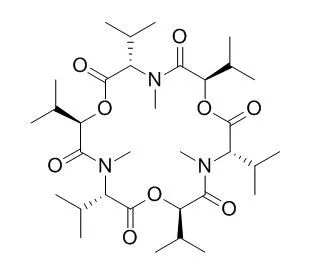| Description: |
Enniatin B has anticancer benefits, especially for the treatment of cervical cancer, it also has antiangiogenic properties, indicated by a strong inhibition of human endothelial cell migration and tube formation. Enniatin B has extensive hepatic metabolism, that reduces in vivo potential, it can decrease Monocytes' endocytosis ability and an increase of CD71. |
| Targets: |
IL Receptor | P450 (e.g. CYP17) |
| In vitro: |
| Toxicon. 2013 Sep;71:1-10. | | Effects of beauvericin, enniatin b and moniliformin on human dendritic cells and macrophages: an in vitro study.[Pubmed: 23685117 ] | The aim of this study was to assess the in vitro effects of emerging mycotoxins beauvericin, Enniatin B and moniliformin on human dendritic cells and macrophages.
METHODS AND RESULTS:
Beauvericin and Enniatin B were cytotoxic on these cells. IC50 were equal to 1.0 μM, 2.9 μM and 2.5 μM beauvericin for immature dendritic cells, mature dendritic cells and macrophages, respectively. IC50 were equal to 1.6 μM, 2.6 μM and 2.5 μM for immature dendritic cells, mature dendritic cells and macrophages exposed to Enniatin B, respectively. Effects on the differentiation process of monocytes into macrophages or into immature dendritic cells as well as effects on dendritic cells maturation have been studied. The differentiation process of monocytes into immature dendritic cells was not disturbed in the presence of beauvericin. Dendritic cells exposed to beauvericin during the maturation process presented a decrease of CCR7 expression and an increase of IL-10 secretion. Monocytes exposed to beauvericin during the differentiation process into macrophages presented a decrease of endocytosis ability.
CONCLUSIONS:
The differentiation process of monocytes into immature dendritic cells was not disturbed in the presence of Enniatin B. Dendritic cells exposed to Enniatin B during the maturation process presented a decrease of expression of the maturation makers CD80, CD86 and CCR7 and an increase of IL-10 secretion. Monocytes exposed to Enniatin B during the differentiation process into macrophages presented a decrease of endocytosis ability and an increase of CD71. | | Drug Metab Dispos. 2011 Sep;39(9):1768-76. | | In vitro metabolism of the mycotoxin enniatin B in different species and cytochrome p450 enzyme phenotyping by chemical inhibitors.[Pubmed: 21622627] | Enniatins are cyclic hexapeptidic mycotoxins produced by fungi growing on field grains, especially in wet climates. They show considerable resistance to food and feed processing technologies and might cause intoxication of humans and animals. Enniatins are also under exploration as anticancer drugs. The observed difference of in vitro and in vivo toxicities suggests low absorption or fast elimination of the enniatins after oral uptake. In the study presented here, in vitro metabolism studies of Enniatin B were performed using rat, dog, and human liver microsomes under conditions of linear kinetics to estimate the respective elimination rates. Furthermore, cytochrome P450 reaction phenotyping with chemical inhibitors selective for human enzymes was carried out. Twelve metabolites were separated and characterized by multiple high-performance liquid chromatographic/mass spectrometric analyses as products of oxidation and demethylation reactions. Biotransformation rates and metabolite patterns varied considerably in the three species. The intrinsic clearances determined in assays with rat, dog, and human liver microsomes were 1.16, 8.23, and 1.13 l/(h · kg), respectively. The predicted Enniatin B in vivo blood clearances were 1.57 l/(h · kg) in rats, 1.67 l/(h · kg) in dogs, and 0.63 l/(h · kg) in humans. CYP3A4 was important for Enniatin B metabolism in human microsomes as shown by 80% inhibition and impaired metabolite formation in the presence of troleandomycin. CYP1A2 and CYP2C19 were additionally involved.
CONCLUSIONS:
Preliminary results showed that CYP3A and CYP1A might also be relevant in rats and dogs. The extensive hepatic metabolism could explain the reduced in vivo potential of Enniatin B. |
|
| In vivo: |
| Biochem Pharmacol. 2015 Feb 1;93(3):318-31. | | The naturally born fusariotoxin enniatin B and sorafenib exert synergistic activity against cervical cancer in vitro and in vivo.[Pubmed: 25557295] | During the last decades substantial progress has been made in developing systemic cancer therapy. However, tumors are frequently intrinsically resistant against structurally and mechanistically unrelated drugs. Thus, it is of predominant interest to overcome drug resistance and to encourage the research for novel chemotherapeutic approaches. Recently, we have introduced enniatins, naturally occurring cyclohexadepsipeptides produced by filamentous fungi of the genus Fusarium, as potential anticancer drugs.
METHODS AND RESULTS:
Here, we expend this approach by demonstrating antiangiogenic properties for Enniatin B (Enn B) indicated by a strong inhibition of human endothelial cell migration and tube formation. Moreover, combination of Enn B with the clinically approved multi-kinase inhibitor sorafenib (Sora) displayed profound synergistic in vitro and in vivo anticancer effects against cervical cancer. Subsequent studies showed that this strong synergism is accompanied by a marked increase in mitochondrial injury and apoptosis induction reflected by mitochondrial membrane depolarization, caspase-7 activation, and subsequent cleavage of PARP. Additionally, cells were shown to stop DNA synthesis and accumulate in S and G2/M phase of the cell cycle. The multifaceted characteristics underlying this strong synergism were suggested to be based on interference with the p38 MAPK as well as the ERK signaling pathways. Finally, also in vivo studies revealed that the combination treatment is distinctly superior to single drug treatments against the KB-3-1 cervix carcinoma xenograft model.
CONCLUSIONS:
Taken together, our data confirm the anticancer benefits of the naturally occurring fusariotoxin Enn B and further present Enn B/Sora as a novel combination strategy especially for the treatment of cervical cancer. |
|






 Cell. 2018 Jan 11;172(1-2):249-261.e12. doi: 10.1016/j.cell.2017.12.019.IF=36.216(2019)
Cell. 2018 Jan 11;172(1-2):249-261.e12. doi: 10.1016/j.cell.2017.12.019.IF=36.216(2019) Cell Metab. 2020 Mar 3;31(3):534-548.e5. doi: 10.1016/j.cmet.2020.01.002.IF=22.415(2019)
Cell Metab. 2020 Mar 3;31(3):534-548.e5. doi: 10.1016/j.cmet.2020.01.002.IF=22.415(2019) Mol Cell. 2017 Nov 16;68(4):673-685.e6. doi: 10.1016/j.molcel.2017.10.022.IF=14.548(2019)
Mol Cell. 2017 Nov 16;68(4):673-685.e6. doi: 10.1016/j.molcel.2017.10.022.IF=14.548(2019)